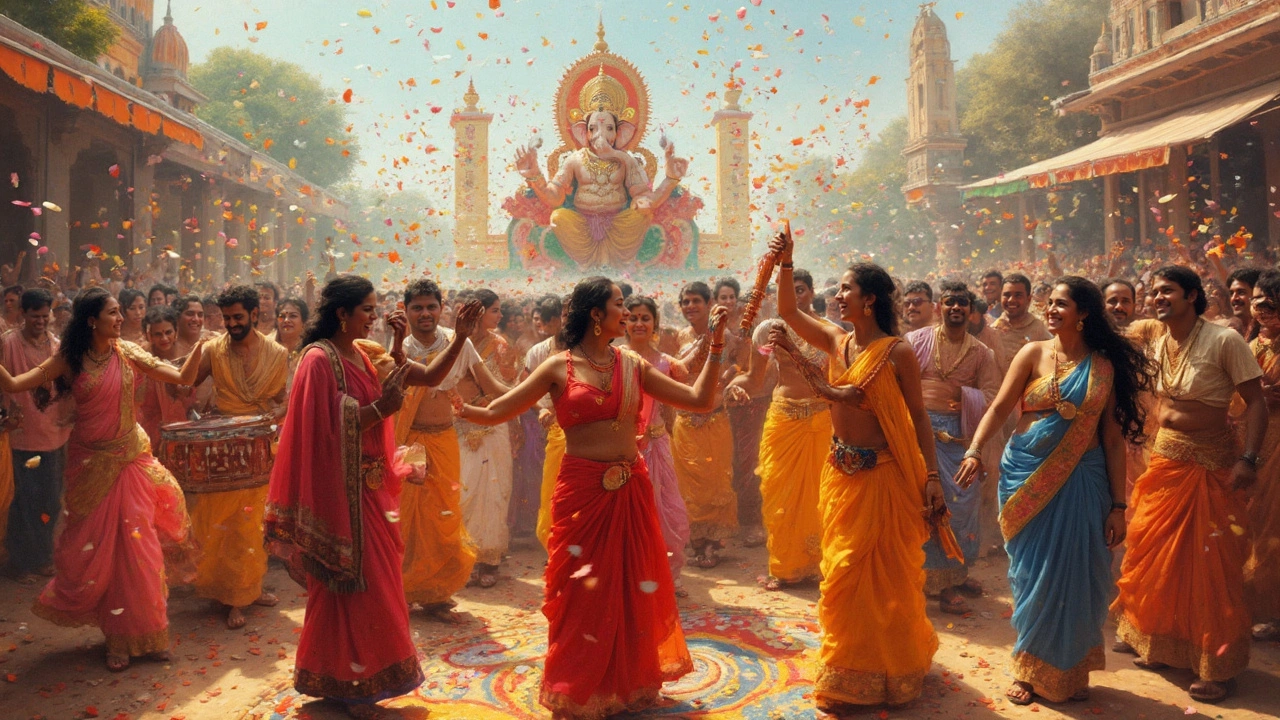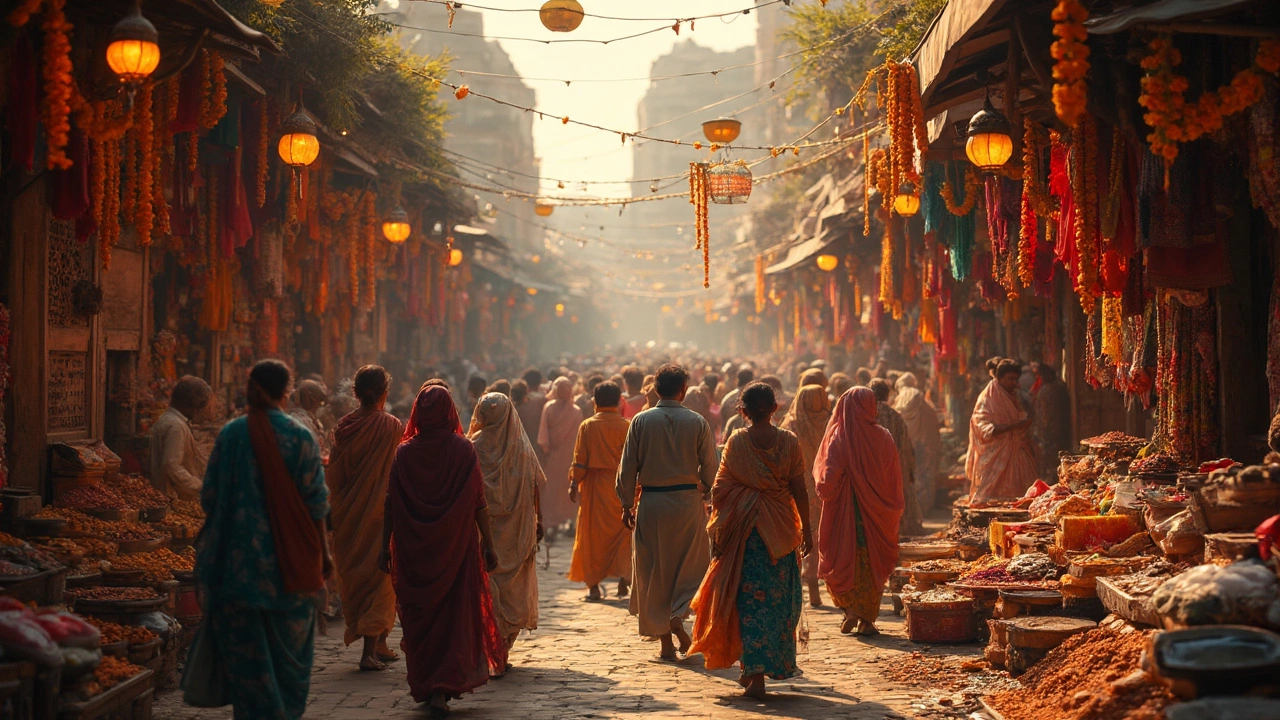Ever tried keeping up with India’s festival calendar? Impossible. There’s almost always a celebration around the corner. That’s just a slice of what makes Indian culture so famous—life here doesn’t hit pause, it keeps the colors, flavors, and noise rolling day and night.
People come from all over mainly because Indian culture isn’t just something you watch. You actually get to join in—dancing in a Holi crowd, eating dosas at a roadside stand, or lighting a lamp in Varanasi at sunset. Culture here isn’t hiding in museums; it’s in the streets, homes, and the air you breathe. If you want to pack your trip with raw experiences, start with a festival, try a local meal, or wander through an old market. Every move you make teaches you something new about how old India is, and how alive it feels.
- The Heartbeat of Indian Traditions
- Festivals That Stop the Country
- Food: A Cultural Adventure in Every Bite
- Tips for Travelers to Experience Culture First-hand
The Heartbeat of Indian Traditions
Step into India and you’ll see that traditions run the show, whether it’s something basic like how people greet each other or huge life events like weddings. People still greet with a simple ‘Namaste,’ pressing their palms together—a sign of respect that’s older than most countries. These habits aren’t just old—they connect across generations.
One thing most folks notice right away is how every part of life, from morning routines to community gatherings, has its own set of rituals. It’s not just about following rules. A lot of homes kick off their day lighting a lamp or doing a small prayer, no matter where they live—city or village. It’s about starting the day with hope and positivity, a thing you won’t miss if you stay with a local family.
Family matters big time here. Most people still live in joint family setups, which means uncles, aunts, cousins, and grandparents all under one roof. This style isn’t just traditional, it actually shapes daily life, decisions, even what’s on the dinner table. Respect for elders isn’t just taught, it’s expected. Talk to anyone, and you’ll find this isn’t just talk—they live it.
What’s wild is India’s obsession with Indian traditions goes hand-in-hand with its mix of religions. Hinduism, Islam, Christianity, Sikhism, Buddhism, and Jainism all have roots here, and you see the proof everywhere. A temple, a mosque, a church, and a gurdwara might sit on the same street, each with their own ways of celebrating. That’s not a rare thing—it’s everyday life.
If you’re an early riser, catch the morning aarti (prayer) on the ghats of Varanasi, where locals and tourists gather by the Ganges as priests wave lamps and chant. Or, see a traditional South Indian wedding. It’s an all-day affair, full of rituals, colors, and food—open to friends, neighbors, sometimes even a few curious guests. Each custom means something, tying the present to centuries of history.
| Major Traditions | Where to Experience |
|---|---|
| Namaste Greeting | All across India |
| Morning Puja (Prayer) | Homes, temples in cities & villages |
| Joint Family Living | Most Indian towns & villages |
| Multi-religious Festivals | Cities like Delhi, Mumbai, Hyderabad |
When you visit for cultural tourism India, plug into daily life and notice how traditions show up everywhere. It’s more than sightseeing—it’s joining a rhythm that’s been going on for ages, and will probably outlast us all.
Festivals That Stop the Country
If you ask anyone what makes India culture stand out on a global scale, you’ll get one word: festivals. India isn’t just a country with a lot of holidays—it’s a place where life actually works around them. There’s a saying that India has more festivals than days in a year, and it actually feels true sometimes.
Let’s talk about a few you’ll want to put on your travel list:
- Diwali: The Festival of Lights is massive—think cities lit up like daytime and fireworks overhead for days. It usually lands in October or November. Houses are cleaned top to bottom, families buy new clothes, and everyone exchanges sweets. It’s almost like Christmas, New Year’s, and July 4th rolled together.
- Holi: The color festival. Expect bright powder flying everywhere and water fights out in the streets. Holi usually kicks off in March, marking the end of winter. Don’t wear your best clothes—you’re not getting them back the same.
- Eid: India’s Muslim communities bring out their best food, clothes, and hospitality. Eid al-Fitr marks the end of Ramadan and is all about sharing feasts with friends, family, and strangers.
- Pongal and Makar Sankranti: Down in southern states like Tamil Nadu, you get Pongal—a harvest festival where sweet rice is boiled and cows get decorated. In states like Gujarat, Makar Sankranti means rooftop kite battles fill the sky.
- Navratri and Durga Puja: In West Bengal, giant statues of the goddess Durga pop up in neighborhoods. In Gujarat, streets turn into late-night dance floors for nine days straight. Both festivals happen in the fall.
These aren’t quiet home affairs. Whole cities change—markets stay open late, trains and buses get packed, and even work schedules shift for the big festivals. Here’s a fun fact: According to the Indian Ministry of Tourism, festival tourism is one of the top reasons international visitors pick India, with peaks in tourism numbers linked directly to dates like Diwali and Holi.
Want a tip? If you’re planning to travel for any big festival, book transport and hotels well in advance. Things fill up fast and prices shoot up. Also, double-check dates—festivals here follow lunar calendars, so they shift each year.
Jumping into an Indian festival is one of the easiest ways to get to know Indian traditions and feel the pulse of the country. It might be loud and a little chaotic, but you’ll see why no other place does celebrations quite like India.

Food: A Cultural Adventure in Every Bite
If you really want to understand India culture, get ready to eat. Every state has its own style, ingredients, and ways of cooking—north, south, east, and west, what’s on your plate totally changes. You can have rich, creamy butter chicken up in Delhi and then get hit with crispy dosa and spicy sambar when you’re down south in Chennai.
Street food is a whole scene by itself. Cities like Mumbai are known for bhel puri—puffed rice mixed with tangy sauces—while Kolkata folks swear by their kathi rolls. And forget boring snacks: samosas, pani puri, and vada pav are proof you don’t need fancy restaurants to eat well in India.
It’s not just the taste, it’s the meaning behind the meals. Food plays a big role in festivals and rituals. During Diwali, for example, homes fill up with sweets like ladoos and barfi. Ramadan in Hyderabad? You’ll spot folks gathering after sunset to break their fast with haleem. Meals often reflect religious and family traditions that go back generations.
- Want something totally unique? Hunt down a thali—a platter loaded with small portions of several dishes. It’s a crash course in balancing sweet, salty, spicy, and sour, all in one meal.
- Vegetarians are in luck here. India has the world’s largest population of vegetarians, and there’s no shortage of plant-based options.
- If you’re serious about a food adventure, take a cooking class while you’re in town. Lots of cities offer basic lessons where you can learn to make chai or roll your own chapati.
| State | Signature Dish | Main Ingredient |
|---|---|---|
| Punjab | Butter Chicken | Chicken, Cream, Spices |
| Tamil Nadu | Dosa & Sambar | Rice, Lentils |
| West Bengal | Fish Curry | Fish, Mustard, Spices |
| Gujarat | Dhokla | Fermented Rice, Chickpeas |
| Maharashtra | Vada Pav | Potato, Bread Roll |
Trying Indian cuisine isn’t just about eating—it’s about seeing how food connects people, families, and centuries of tradition. Don’t just snap photos—taste something new at every stop, and you’ll end up with way better stories than just the food pics.
Tips for Travelers to Experience Culture First-hand
If you want to really get India’s vibe, you can’t just check out the monuments and move along. Immersing in India culture needs a bit more effort, but it’s totally worth it. Here’s how you can swap touristy snapshots for some real stories and memories.
- Join a Local Festival
Catching a festival like Diwali, Holi, or Ganesh Chaturthi isn’t hard—there’s always something big on, no matter the month. Even small towns get in on the action. For Holi, go to Mathura for wild color-throwing, or for Diwali, Varanasi’s riverfront is unreal with thousands of candles lighting up the ghats. - Eat with Locals
Indian hospitality is legendary. Don’t stick to hotel food—sign up for a home-cooked meal experience or cooking class. Sites like Authenticook and local hosts in Delhi or Jaipur invite visitors for dinner. This is the fastest way to try real Indian cuisine and swap stories. - Take a Culture Walk
Walking tours in cities like Mumbai, Kolkata, and Hyderabad pull you into neighborhoods most tourists miss. For example, “Delhi Food Walks'' takes you through Chandni Chowk, showing both the alleys and what’s actually cooking on those smoky stoves. Guides share facts you won’t find in guidebooks. - See a Traditional Performance
Checking out a Kathakali or Bharatanatyam dance in Kerala or Tamil Nadu is eye-opening. Don’t expect to understand every gesture, but you’ll get a feel for storytelling that’s older than most countries. - Shop Like a Local
Markets are chaos but full of life. Skip the malls and try local bazaars like Jaipur’s Johari Bazaar for jewelry, Delhi’s Dilli Haat for handicrafts, or Lucknow’s markets for chikankari embroidery. Bargain a bit, it’s part of the fun!
| Festival | Month | Main Locations |
|---|---|---|
| Holi | March | Mathura, Barsana, Delhi |
| Diwali | October/November | Varanasi, Jaipur, Mumbai |
| Durga Puja | September/October | Kolkata |
Always remember to dress and act respectfully at religious spots—long pants, shoulders covered, no shoes inside temples. Small things like learning a bit of Hindi (“Namaste” and “Shukriya” take you far) go a long way. If you travel slow and stay open, cultural tourism India turns into something personal, not just another stamp in your passport.
